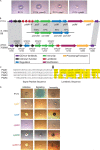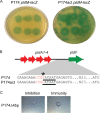Characterization of a Multipeptide Lantibiotic Locus in Streptococcus pneumoniae
- PMID: 26814178
- PMCID: PMC4742701
- DOI: 10.1128/mBio.01656-15
Characterization of a Multipeptide Lantibiotic Locus in Streptococcus pneumoniae
Abstract
Bacterial communities are established through a combination of cooperative and antagonistic interactions between the inhabitants. Competitive interactions often involve the production of antimicrobial substances, including bacteriocins, which are small antimicrobial peptides that target other community members. Despite the nearly ubiquitous presence of bacteriocin-encoding loci, inhibitory activity has been attributed to only a small fraction of gene clusters. In this study, we characterized a novel locus (the pld locus) in the pathogen Streptococcus pneumoniae that drives the production of a bacteriocin called pneumolancidin, which has broad antimicrobial activity. The locus encodes an unusual tandem array of four inhibitory peptides, three of which are absolutely required for antibacterial activity. The three peptide sequences are similar but appear to play distinct roles in regulation and inhibition. A modification enzyme typically found in loci encoding a class of highly modified bacteriocins called lantibiotics was required for inhibitory activity. The production of pneumolancidin is controlled by a two-component regulatory system that is activated by the accumulation of modified peptides. The locus is located on a mobile element that has been found in many pneumococcal lineages, although not all elements carry the pld genes. Intriguingly, a minimal region containing only the genes required for pneumolancidin immunity was found in several Streptococcus mitis strains. The pneumolancidin-producing strain can inhibit nearly all pneumococci tested to date and provided a competitive advantage in vivo. These peptides not only represent a unique strategy for bacterial competition but also are an important resource to guide the development of new antimicrobials.
Importance: Successful colonization of a polymicrobial host surface is a prerequisite for the subsequent development of disease for many bacterial pathogens. Bacterial factors that directly inhibit the growth of neighbors may provide an advantage during colonization if the inhibition of competitors outweighs the energy for production. In this work, we found that production of a potent antimicrobial called pneumolancidin conferred a competitive advantage to the pathogen Streptococcus pneumoniae. S. pneumoniae secreting pneumolancidin inhibits a wide array of Gram-positive organisms, including all but one tested pneumococcal strain. The pneumolancidin genetic locus is of particular interest because it encodes three similar modified peptides (lantibiotics), each of which has a distinct role in the function of the locus. Lantibiotics represent a relatively untapped resource for the development of clinically useful antibiotics which are desperately needed. The broad inhibitory activity of pneumolancidin makes it an ideal candidate for further characterization and development.
Copyright © 2016 Maricic et al.
Figures





Similar articles
-
Characterization of the Competitive Pneumocin Peptides of Streptococcus pneumoniae.Front Cell Infect Microbiol. 2019 Mar 12;9:55. doi: 10.3389/fcimb.2019.00055. eCollection 2019. Front Cell Infect Microbiol. 2019. PMID: 30915281 Free PMC article.
-
The pneumococcal bacteriocin streptococcin B is produced as part of the early competence cascade and promotes intraspecies competition.mBio. 2025 Feb 5;16(2):e0299324. doi: 10.1128/mbio.02993-24. Epub 2024 Dec 17. mBio. 2025. PMID: 39688419 Free PMC article.
-
Inhibition of pneumococcal growth and biofilm formation by human isolates of Streptococcus mitis and Streptococcus oralis.Appl Environ Microbiol. 2025 Mar 19;91(3):e0133624. doi: 10.1128/aem.01336-24. Epub 2025 Feb 26. Appl Environ Microbiol. 2025. PMID: 40008876 Free PMC article.
-
Lantibiotic production by pathogenic microorganisms.Curr Protein Pept Sci. 2012 Sep;13(6):509-23. doi: 10.2174/138920312803582997. Curr Protein Pept Sci. 2012. PMID: 22708496 Review.
-
Streptococcus pneumoniae two-component regulatory systems: The interplay of the pneumococcus with its environment.Int J Med Microbiol. 2018 Aug;308(6):722-737. doi: 10.1016/j.ijmm.2017.11.012. Epub 2017 Nov 26. Int J Med Microbiol. 2018. PMID: 29221986 Review.
Cited by
-
Profiling microorganisms in whole saliva of children with and without dental caries.Clin Exp Dent Res. 2019 Jun 20;5(4):438-446. doi: 10.1002/cre2.206. eCollection 2019 Aug. Clin Exp Dent Res. 2019. PMID: 31452955 Free PMC article.
-
Inhibitory effect of streptococci on the growth of M. catarrhalis strains and the diversity of putative bacteriocin-like gene loci in the genomes of S. pneumoniae and its relatives.AMB Express. 2017 Dec 13;7(1):218. doi: 10.1186/s13568-017-0521-z. AMB Express. 2017. PMID: 29236192 Free PMC article.
-
Characterization of the Competitive Pneumocin Peptides of Streptococcus pneumoniae.Front Cell Infect Microbiol. 2019 Mar 12;9:55. doi: 10.3389/fcimb.2019.00055. eCollection 2019. Front Cell Infect Microbiol. 2019. PMID: 30915281 Free PMC article.
-
The pneumococcal social network.PLoS Pathog. 2020 Oct 29;16(10):e1008931. doi: 10.1371/journal.ppat.1008931. eCollection 2020 Oct. PLoS Pathog. 2020. PMID: 33119698 Free PMC article. Review.
-
Proteomic Characterization of Antibiotic Resistance, and Production of Antimicrobial and Virulence Factors in Streptococcus Species Associated with Bovine Mastitis. Could Enzybiotics Represent Novel Therapeutic Agents Against These Pathogens?Antibiotics (Basel). 2020 Jun 4;9(6):302. doi: 10.3390/antibiotics9060302. Antibiotics (Basel). 2020. PMID: 32512932 Free PMC article.
References
Publication types
MeSH terms
Substances
Grants and funding
LinkOut - more resources
Full Text Sources
Other Literature Sources
Molecular Biology Databases

